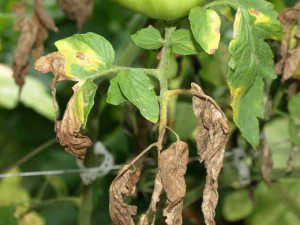 Blights, wilts, and viruses are just a few of the terms that many backyard gardeners have received a rude and unwanted introduction to this growing season.
Blights, wilts, and viruses are just a few of the terms that many backyard gardeners have received a rude and unwanted introduction to this growing season.
Although diseases can appear despite your best efforts, if you’re familiar with their symptoms and the controls that can be used against them, you’ll have a better chance of stopping them before they can become a problem.
Sensible Cultural Practices to Keep Plant Diseases at Bay
While good gardening practices will fend off many diseases, you can’t always prevent a disease from attacking a prized plant. To help keep plant problems under control, try taking the following steps:
- Transplant Carefully – This minimizes root damage. When broken, roots are susceptible to certain soil born diseases.
- Keep Plants Healthy – Give them the water, light and fertilizer they need to flourish.
- Keep the Garden Clean – Do a thorough fall cleanup each year utilizing your favorite garden tools. Remove weeds, since pathogens may over-winter on them. Strip off any diseased leaves remaining on plants and rake up and discard all diseased leaves on the ground. You may also want to rake up other garden debris, though; if not diseased, it can serve as good mulch.
- Buy Disease-Resistant Plants – Vegetable seed packets are labeled to indicate the particular plant’s disease resistance. Plant tags on fruit trees or ornamental trees and shrubs also contain this information.
- Take Care Not To Injure Plants – An open wound on a plant stem or tree trunk readily admits bacteria and fungi.
- Avoid Wet Weather Garden Work – You may unwittingly spread water-borne pathogens as you move about from one spot to the next.
- Remove Diseased Plants – If certain plants are constantly afflicted by disease, eliminate them from the garden and replace them with less troublesome choices. This solution is simpler than trying to control the disease, and it removes the source of further infection.
- Install a Drip Irrigation System – Minimize the splashing water that can spread water-borne pathogens.
Unfriendly Sources of Backyard Garden Diseases
Fungi, bacteria and viruses are the pathogens most often responsible for plant diseases. Unlike green plants, these organisms are incapable of manufacturing their own food and must instead take it from a host plant. Fungi can live in the soil, but the bacteria and viruses that cause plant problems cannot survive outside of their host.
Fungi multiply by tiny reproductive bodies called spores, which they produce in great quantity. Spores of some fungi enter plants through the roots; others land on leaves, where they attach and complete their life cycle.
Simple Organisms Create Complex Problems
Bacteria need water and warmth to multiply, so the diseases they cause tend to be more prevalent in warm, wet climates. These single-celled organisms enter plants through wounds and cuts.
Viruses are even smaller than bacteria; they can reproduce only within the actual cells of the host organism. Some viruses are transmitted by insects such as aphids, leafhoppers and thrips; others are carried by infected seeds and pollen. Viruses also enter plants through wounds and cuts.
Originally posted at: Lafayette Real Estate News






